
It was about Holbrook, around four hours into my trip I realised nobody was ever going to wear out a Gen-F HSV Clubsport driving along the Hume highway.
This article first published in MOTOR December 2013.
At a legal 110km/h, the 6.2-litre engine was cranking just over 1650rpm. I then started some mental arithmetic, which probably says more about the Hume Freeway than it does about me or the car but, off the top of your head, how many times do you reckon the engine in a Clubsport turns over on a 500km trip?

Assuming I did the whole trip in sixth gear (which is more or less how it pans out on the Hume) I figured the HSV’s crankshaft was going to turn over just 427,500 times. Like I said, premature bore wear is not your biggest worry.
Even though the Chrysler 300 SRT8 Core is geared a little lower, it still gives the impression of being able to stride across States and territories without cracking a sweat. Yet sink the clog and either car makes a bee-line for the horizon with long, long legs and each of the car’s huge torque outputs would be the over-riding impression left on the occupants.
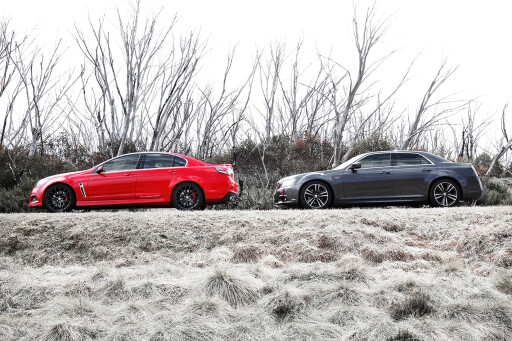 On that basis, then, what we’re dealing with here are proper muscle cars. By any definition, the combination of performance and staying power has muscle car written all over it. And what’s perhaps even more interesting here is both the HSV and the Chrysler are not the top-rung models.
On that basis, then, what we’re dealing with here are proper muscle cars. By any definition, the combination of performance and staying power has muscle car written all over it. And what’s perhaps even more interesting here is both the HSV and the Chrysler are not the top-rung models.
In fact, the Clubsport is the entry-level HSV right now and the Core is the no-frills version of the 300 SRT8. And when you think back to the golden era of tough cars, vinyl floor mats, bench seats and steel rims were no barrier to membership of the ’60s and ’70s muscle-car club.
But surely, there’s no such thing as a stripper muscle car these days. Is there? Well, yes, actually, and even though you still get a level of standard kit that leaves most budget cars gagging, when you consider that it’s possible to spend $71,290 on an HSV Clubsport R8 manual and $66,000 on a 300 SRT8, then the $60,990 of the Clubby here and the $56,000 of the SRT8 Core start to sound like bargains.
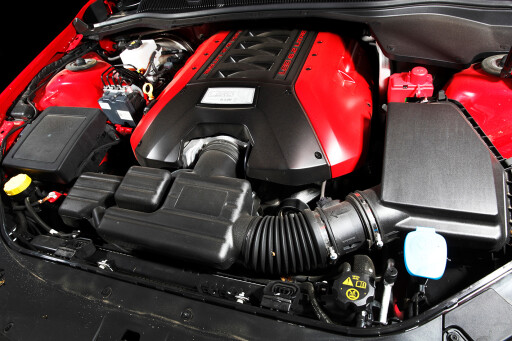 In the case of the HSV, you don’t get the R8’s 325kW engine or its bi-modal exhaust. But, then again, 317kW is nothing to scoff at, especially when even the most sensitive of drivers won’t notice an extra eight kW when the total power is beyond 300. And anyway, the torque output of 550Nm is the same for either version.
In the case of the HSV, you don’t get the R8’s 325kW engine or its bi-modal exhaust. But, then again, 317kW is nothing to scoff at, especially when even the most sensitive of drivers won’t notice an extra eight kW when the total power is beyond 300. And anyway, the torque output of 550Nm is the same for either version.
The Clubby also skips out on leather seats (the cloth alternative ain’t too foul, though) and there’s none of the R8’s forward-collision-warning stuff or head-up display. The auto wipers are diced and you only get four-way (not eight) power adjustment for the driver’s chair. You also miss out on the Bose stereo and cup-holders in the rear seat pad. Boo-hoo.
As for the SRT8 Core, you still get all 6.4 litres and, therefore, the full 347kW of Hemi fury. Like the HSV, the Core also does without leather and the dampers are now Bilstein non-adjustable units. You still get 20-inch wheels and tyres, although the rims are cast, not forged, and sat-nav is an extra-cost option rather than standard as it is on the full-fat SRT8.
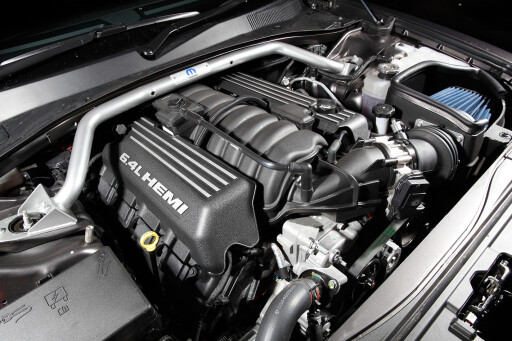 Beyond that, it’s finer things the Core loses. Things like the high-line stereo, reversing camera (but you do get parking sensors at both ends, whereas the Clubby keeps its camera) and the heated front seats. And while the cup-holders are not the heated/cooled/illuminated jobs of the SRT8, I’m reliably informed they will still, in fact, hold a cup.
Beyond that, it’s finer things the Core loses. Things like the high-line stereo, reversing camera (but you do get parking sensors at both ends, whereas the Clubby keeps its camera) and the heated front seats. And while the cup-holders are not the heated/cooled/illuminated jobs of the SRT8, I’m reliably informed they will still, in fact, hold a cup.
Neither car feels poverty-pack from the inside, and the HSV actually manages to feel a bit fussy with about nine different trim materials on the door panels and lots of shiny, blinding chrome trims accents. But the Chrysler still feels a bit too American, and that applies to the full-spec SRT8 as well. Both their interiors have a slightly cheaper look and feel to the plastics compared to cars from countries where ‘fast’ is not a major food group.
Thundering along a piece of highway ain’t the romantic road trip most of us have in mind, but it’s the reality for many (most) interstate trips. And it’s here that the first differences make themselves known.
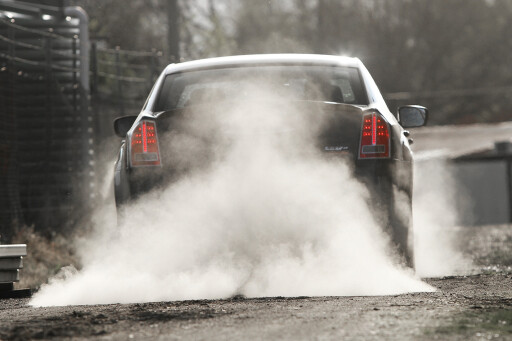 Inside, the Chrysler’s definitely noisier than the HSV and the temptation is to think this is down to the Mopar accessory exhaust, along with a front strut brace and an aftermarket air-filter, fitted to this car for Curt’s recent fang in the Adelaide Tarmac Rally. Turns out the real culprits are the suspension and tyres, although it’s never especially terrible.
Inside, the Chrysler’s definitely noisier than the HSV and the temptation is to think this is down to the Mopar accessory exhaust, along with a front strut brace and an aftermarket air-filter, fitted to this car for Curt’s recent fang in the Adelaide Tarmac Rally. Turns out the real culprits are the suspension and tyres, although it’s never especially terrible.
In terms of ride quality it’s a bit of a dead-heat. Neither car gets adjustable damping but I don’t think either of them suffers for that. In fact, it’s nice to just jump in and blast off without having to worry about what mode the suspension is in. ‘I’ve paid for it so I should use it’ can be a pain in the date sometimes. This also relegates the adjustable driver modes to only control throttle and gearshift profiles in the SRT8 whereas the Clubsport also adjusts steering weight.
Speaking of steering, the Chrysler feels like there’s some deliberate weight in the system but it doesn’t translate to actual feel. On the other hand, its front-end does point well and turn-in is quite impressive for a car that, from the helm, gives the impression of being a bit old school.
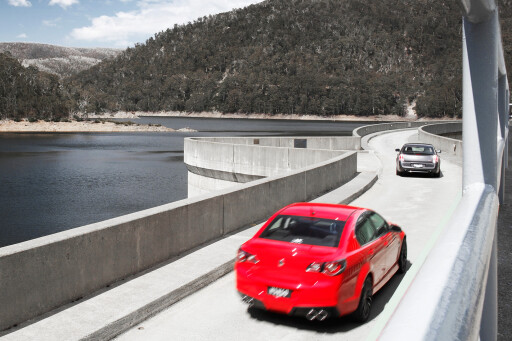 Sounds like I’m damning it with faint praise but I’m not, it’s simply the HSV has a better relationship between the commands being fed into the steering column and the information that comes back to you in return.
Sounds like I’m damning it with faint praise but I’m not, it’s simply the HSV has a better relationship between the commands being fed into the steering column and the information that comes back to you in return.
But it pays to mention this particular car is the best steering VF Commodore I’ve sampled to date. The last Gen-F GTS I drove didn’t impress me with its steering feel or weighting, so maybe the Clubsport’s simpler parts, like the lighter engine and non-adjustable dampers, means its better for it.
Then again, it could be the dreaded production line tolerances. Holden isn’t the only car-maker to have had tolerance issues over the years, and I’m wondering whether this car is just a ‘sweet’ one.
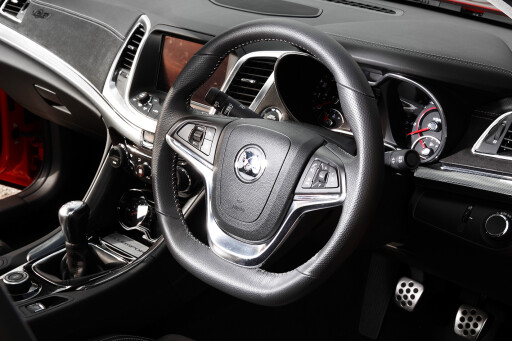 I think it might be. Flooring the throttle after a refuelling stop also reveals the truth between these two car’s transmissions. Essentially, the six-speed manual of the HSV just seems a bit pointless in these conditions. Even though – as I mentioned – this Clubby is a particularly sweet example, there’s still some driveline shunt at low speeds.
I think it might be. Flooring the throttle after a refuelling stop also reveals the truth between these two car’s transmissions. Essentially, the six-speed manual of the HSV just seems a bit pointless in these conditions. Even though – as I mentioned – this Clubby is a particularly sweet example, there’s still some driveline shunt at low speeds.
Why Holden can’t engineer this out of its manual cars is a question that has been cropping up now since the very first Commodore with a two-piece tail-shaft. And I’m yet to find out the answer. The six-speed auto is a much nicer thing to live with.
So you’d imagine, then, that the auto in the SRT8 is a better bet. Well, it is and it isn’t. Given that the Chrysler family (via Jeep) now has access to the rather sensational eight-speed auto in the Grand Cherokee, I’m surprised the eight-speed tranny hasn’t found its way into the 300.
 Maybe it will, maybe there’s some engineering reason (like the trans tunnel is too tight or something) and we’ll have to wait until the next-gen 300 SRT8. Anyway, for now, it’s five ratios and big gaps between the lower gears. There’s also some thump on hard upshifts as 631Nm looks for a way out. It’s not evil, but it’s not state-of-the-art either.
Maybe it will, maybe there’s some engineering reason (like the trans tunnel is too tight or something) and we’ll have to wait until the next-gen 300 SRT8. Anyway, for now, it’s five ratios and big gaps between the lower gears. There’s also some thump on hard upshifts as 631Nm looks for a way out. It’s not evil, but it’s not state-of-the-art either.
But once you’re clear of the freeway and you can start to use what’s on offer, the picture changes again. It soon becomes obvious that even though the HSV gives away 30kW and about 80Nm to the big Yank, those bigger peaks are eaten up by the Chrysler’s almost two-tonne weighbridge ticket.
Okay, so the HSV’s no featherweight, either, but its fewer kilos and the fact the engine seems tuned to enjoy tacho-bashing means it’s a tad more enjoyable. It’s also here that your decision to tick the manual box will pay you dividends.
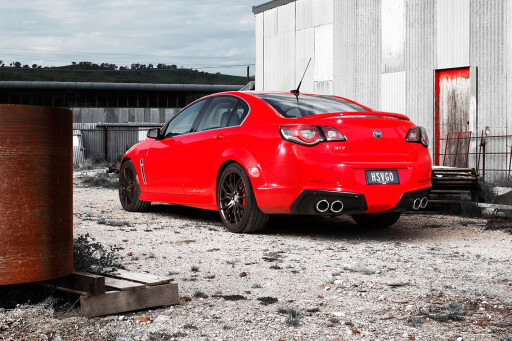 Its more faithful steering also puts the Clubby at an advantage when it starts to get really gnarly and – even though tight, twisting, second-gear corners are not the natural environment for any car this big – the HSV seems to hang in there longer with less push-understeer. The SRT8, meanwhile, is fine right up to about eight-tenths and then starts to deteriorate.
Its more faithful steering also puts the Clubby at an advantage when it starts to get really gnarly and – even though tight, twisting, second-gear corners are not the natural environment for any car this big – the HSV seems to hang in there longer with less push-understeer. The SRT8, meanwhile, is fine right up to about eight-tenths and then starts to deteriorate.
What felt like steering weight on the freeway becomes a touch of looseness at speed in a tight corner. And the suspension control that seemed fine on the Hume suddenly starts to feel a bit underdone. Grip levels vary at this end of things, too, and the HSV feels like it has more tyre on board and reserve braking headroom built into it. We are, of course, talking about situations where you have long ago exceeded the vehicle’s design brief, and any generally accepted notion of sanity.
A few years back, Motor wouldn’t have even have discussed fuel economy in a yarn like this, but in 2013 it simply can’t be avoided. And, despite what you might think, the news ain’t bad. Both cars, over a mix of freeway cruising and back-road thrashing, averaged a credible 13.5 litres per 100km.
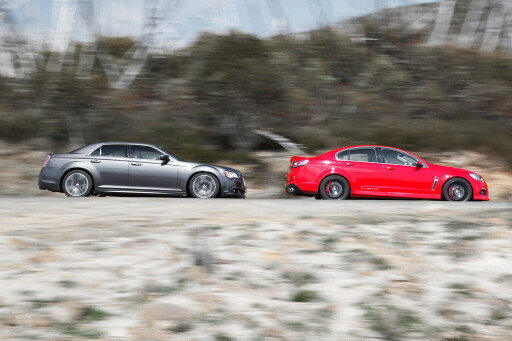 Driven exclusively in cruise mode, I’ve no doubt each could beat 10 litres per 100km in the real world, but even our test figures aren’t bad considering the performance potential these cars each pack.
Driven exclusively in cruise mode, I’ve no doubt each could beat 10 litres per 100km in the real world, but even our test figures aren’t bad considering the performance potential these cars each pack.
I have a feeling that for most people in the market for either of these, much of the purchasing decision will come down to the image and the perception that comes bundled up with either. Maybe the “gangsta” scene is your thing, in which case the Chrysler becomes the obvious choice.
 Or maybe it’s the whole self-made/tradie-made-good image HSV has been pushing for years. That said, for every buyer who feels that way, there are probably others who don’t consider rap to be real music, and even more who don’t have a trip to ‘The Shire’ planned.
Or maybe it’s the whole self-made/tradie-made-good image HSV has been pushing for years. That said, for every buyer who feels that way, there are probably others who don’t consider rap to be real music, and even more who don’t have a trip to ‘The Shire’ planned.
Naturally, I couldn’t possibly comment on such cultural matters, so when the rubber hit the road and I had to choose which car I’d drive a long distance on a mix of conditions, the home-grown HSV would get the nod. But not by as much as you’d think.

COMMENTS